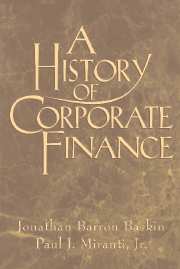Book contents
- Frontmatter
- Contents
- Preface
- Introduction: History and the Modern Theory of Finance
- Part I The Preindustrial World
- Part II The Rise of Modern Industry
- 4 Finance in the Age of Canals and Railroads, 1775–1900
- 5 Common Stock Finance and the Rise of Managerial Capitalism, 1900–1940
- Part III The Transition to the Contemporary Era
- Epilogue
- APPENDIX A Finance and Informational Asymmetries in the Ancient World
- APPENDIX B International Patterns of Corporate Governance
- Index
5 - Common Stock Finance and the Rise of Managerial Capitalism, 1900–1940
Published online by Cambridge University Press: 22 March 2010
- Frontmatter
- Contents
- Preface
- Introduction: History and the Modern Theory of Finance
- Part I The Preindustrial World
- Part II The Rise of Modern Industry
- 4 Finance in the Age of Canals and Railroads, 1775–1900
- 5 Common Stock Finance and the Rise of Managerial Capitalism, 1900–1940
- Part III The Transition to the Contemporary Era
- Epilogue
- APPENDIX A Finance and Informational Asymmetries in the Ancient World
- APPENDIX B International Patterns of Corporate Governance
- Index
Summary
Introduction
This chapter focuses on investors' growing interest in corporate common stock during the first four decades of the twentieth century. Although broad, anonymous markets for equity-share trading emerged in many centers worldwide, our discussion concentrates on developments in the foremost market for these securities of this period, the New York Stock Exchange (NYSE) on Wall Street, where a growing population of middle-class investors goaded by the prospects of capital gains and increasing dividends committed resources to industrial and utility shares. The increasing importance of equity is reflected in NYSE statistics: total annual share turnover rose from 159 million in 1900 to 1.1 billion at the height of the 1929 boom; the value of preferred and common stocks underwritten amounted to $405 million in 1910 and increased to $9.4 billion in 1929; and Standard and Poor's Composite Common Stock Index (1941–43 = 10.0) zigzagged upward from 6.15 in 1900 to 26.02 in 1929. The transition to broader common stock ownership in the United States was facilitated by the rise of what Alfred D. Chandler has termed “managerial capitalism.” Large-scale, hierarchical business enterprises whose activities were controlled by professional managers became the source of great economic efficiency in both the manufacturing and utilities sectors. Although first evident during the last quarter of the nineteenth century, firms of this caliber came to full flourish during the 1920s, many growing strongly because of their ability to exploit opportunities associated with the advent of the internal combustion engine or electrical power.
- Type
- Chapter
- Information
- A History of Corporate Finance , pp. 167 - 210Publisher: Cambridge University PressPrint publication year: 1997
- 1
- Cited by



